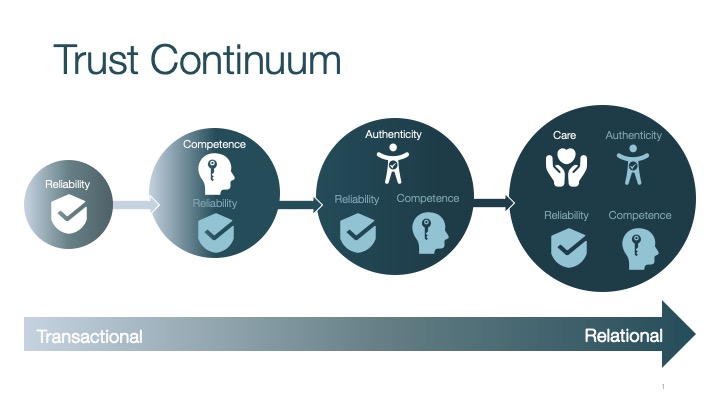The Hard Truth About High-Performing Leadership Teams: Trust Is Non-Negotiable

by Siobhan Smith, Co-President
Everyone talks about trust—but most leadership teams do not fully understand what it unlocks.
Many teams operate with a base level of trust—enough to function, enough to get by. But staying in this transactional zone comes at a cost. Without moving toward deeper, relational trust, teams miss out on the very thing that drives peak performance: the ability to access their full collective intelligence, make bold decisions, and achieve results with both excellence and engagement. If you want a winning team that’s committed and connected—not just compliant—trust isn’t optional. It is everything.
Through our work with leadership teams, we have developed a practical and powerful model called the Trust Continuum. It is grounded in research, experience, and countless hours in rooms where real leadership happens—and sometimes doesn’t.
Trust is Built Along a Continuum
Trust is not binary. It doesn’t simply exist or not exist. It builds over time through behaviors, choices, and shared experiences. On high-performing teams, trust evolves along a continuum—from basic transactional trust to deeper, more powerful relational trust.
At the transactional end, trust allows the team to operate. At the relational end, trust allows the team to transform. The further a team travels along the continuum, the more open, resilient, and results-driven they become.
There are four core components of trust. Each one builds on the last:
- Reliability
Trust begins with consistency. Do people follow through on commitments? Can others count on them to do what they say they will? This is the foundation of transactional trust. - Competence
Next comes capability. Are team members skilled and knowledgeable? Do they deliver high-quality work? When reliability and competence are both present, teams experience basic operational trust—we get things done.
These two elements form transactional trust. Necessary for function, but insufficient for transformation.
- Authenticity
Relational trust begins when people are willing to show up as their full selves. Can leaders express their perspectives, even when it’s uncomfortable? Can they disagree respectfully? Authenticity creates space for truth, learning, and better decisions. - Care
The final layer is care. Do they have each other’s backs? Can they challenge one another and still move forward together? Do they act with empathy and shared commitment? Care turns a group of individuals into a team.
With all four components present, relational trust becomes possible—and with it, true collaboration and high performance.
Why Leadership Teams Get Stuck
Many leadership teams master transactional trust. They’re reliable. They’re competent. But they hesitate at the threshold of authenticity and care. Vulnerability feels risky. Conflict feels threatening. And the desire to maintain individual credibility often overrides the need for collective progress.
In a recent session, a leadership team I worked with wanted breakthrough results—but hesitated to surface real concerns and executive-level tensions. Their potential was capped not by capability, but by a lack of relational trust.
What Enables the Shift
Moving from transactional to relational trust doesn’t just take time—it takes intention. Here are the conditions that help:
- Self-Awareness
Leaders must know their own impact—and be willing to adjust. - Shared Purpose & Aligned Intentions
Trust deepens when everyone is committed to the same outcome. - Reciprocity
Trust must be mutual. It can’t be one-directional or based on position alone. - Courage
Trust grows when leaders speak the truth, even when it’s uncomfortable. - Mindset
Be curious before being critical. Assume positive intent. Use active listening and inquiry to seek understanding. When in doubt, tools like “Ask Me / Tell Me” can help navigate tough conversations.
Final Thought
Trust isn’t soft. It’s strategic. It’s the invisible force that accelerates execution, deepens collaboration, and sustains performance.
As a leader, your job isn’t just to hope for trust—it is to build it. To guide your team from functional to transformational. And to model what that trust looks like, every day.
Where is your team today—stuck in transactional trust or stepping into something deeper? And what will it take to move forward—together? Find out more by contacting Catapult.
Reference: The Thin Book of Trust, Third Edition: An Essential Primer for Building Trust at Work by Charles Feltman
Return to all posts